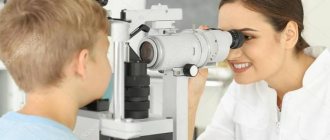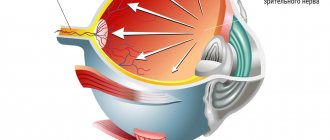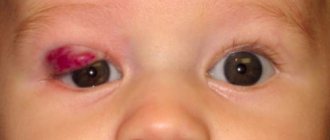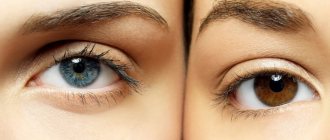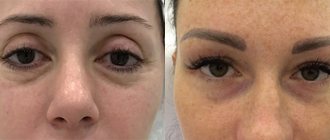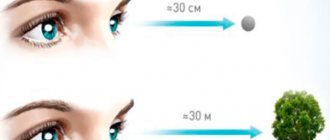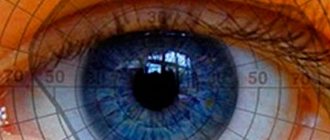Why is myopia often diagnosed in children?
Myopia is a refractive error in which a person cannot clearly see distant objects, but sees well near.
In this article
- Why is myopia often diagnosed in children?
- What problems does a child face with myopia?
- Is it possible to stop myopia in children?
- Correcting myopia with glasses or contact lenses
- Drug treatment and physiotherapy
- How is myopia treated surgically in children?
- Prevention of myopia in children
This occurs due to the image's focus shifting. It is “placed” not on the retina, but in front of it. This visual impairment is sometimes congenital. The main reasons for its occurrence:
- genetic factor;
- illnesses suffered by a woman during pregnancy;
- birth injuries.
Very often, myopia develops at school age. Doctors attribute this to an increase in visual load and active growth of the eyeball. In myopic people it stretches out and takes on an oval shape. The optical power of the cornea ceases to correspond to the anteroposterior axis of the eyeball. This causes the focus of the image to shift. In children, myopia is often diagnosed between the ages of 8 and 12 years. This is due to the sharp increase in loads on the visual apparatus that arise when starting school. During adolescence, refractive error continues to progress. By the end of school, almost a third of students become myopic.
Progressive myopia: what are the causes and how to stop
In the modern pace of life, our eyes are under enormous strain: we do most of the work close, we constantly use electronic devices and gadgets. And suddenly we notice: our eyes are tired, our vision decreases after a working day. This may be due to progressive myopia. What is it and how to deal with it?
What is progressive myopia
Let's start with what myopia is. Nearsightedness (or myopia) is a vision defect where light rays are refracted through the clear part of the eye and focused in front of the retina. As a result, the eye sees distant objects blurry. For the eye to see clearly, light rays must focus on the retina.
Myopia can be stationary, that is, the vision indicator remains stable. And if visual acuity worsens over time, then such myopia is called progressive.
With progressive myopia, vision may not decrease too noticeably, so it is worth visiting an ophthalmologist every six months. This will allow you to monitor the situation over time.
Myopia can progress in different ways:
- Fast - from one diopter and more per year.
- Slowly - no more than 1 diopter per year.
Myopia usually begins and progresses before age 18. This is due to the growth of the child's eyeball. In adults, the eye has already grown, and myopia is most often stable. But it happens that myopia appears in adulthood. Such cases, as doctors note, appeared relatively recently, and myopia in such cases is small - 0.5–0.7 diopters.
What is the danger of progressive myopia?
With progressive myopia, the eyeball changes. It lengthens, and there is a lack of nutrition of the eye tissues, ruptures and complications appear. If no action is taken, visual acuity may drop to 20–30 diopters.
What are the causes of progressive myopia
The reasons why vision decreases are associated with excessive and prolonged stress on the visual system, especially near. Working on a computer, telephone and other gadgets can have a great influence on the progression of myopia.
In ophthalmology there is a diagnosis - habitually excessive tension of accommodation (PINA). With excessive visual strain, a spasm of the ciliary muscle occurs, which changes the curvature of the lens. About the same thing happens to the muscles of a marathon runner who runs 40 km. PINA can lead to the formation of false myopia, which in turn will lead to permanent persistent myopia.
There is no need to be afraid of this diagnosis if you take timely measures.
It is necessary to ensure that there is no excessive visual stress, and if your eyes are tired, take breaks from work and relax your eyes with vision exercises.
How to stop progressive myopia
When a person is nearsighted, he constantly squints. It turns out to be a vicious circle: a person squints, the eye strains, and vision decreases. What to do in this case and how to stop the progression of myopia? Doctors recommend:
- Relieve tension from the eyes. This is done through correction with glasses or lenses. They must be 100% correct.
- Maintain good occupational and rest hygiene: take breaks every 30 minutes during any close work. During the break, it is recommended to do something not related to visual stress - for example, take out the trash, walk the dog.
- Take care of the visual system: regularly do eye exercises, eat right.
For children, in addition to these points, doctors may prescribe hardware treatment or orthokeratological lenses.
Interesting fact. Some scientists believe that human eyes are not designed for close-up work. Evolutionarily, we have not reached this point. The main function of the eyes, according to this theory, is to see a predator from afar in order to have time to run away and hide. Therefore, our eyes are more tuned to distance vision. Statistics support this theory: myopia is the most common disease compared to farsightedness and astigmatism.
Is it possible to do laser correction for progressive myopia?
Stationary and progressive myopia is corrected with glasses or lenses. But what should people do who are intolerant to these correction agents? Unfortunately, this also happens. But what about playing certain sports or climbing mountains when you have to constantly wear glasses or contacts? In this case, laser vision correction would be a good solution.
Laser vision correction can be done when the progression of myopia has stopped. That is, vision should be stable for at least six months. To do this, you need to see an ophthalmologist once every six months and save all the data on the examinations. Then the doctor will be able to see the situation in dynamics and recommend surgery when possible.
If you notice that your vision is deteriorating, it is recommended to consult an ophthalmologist. During a comprehensive vision diagnostics, your doctor will be able to determine what is causing your deterioration and recommend means and methods to stabilize your vision.
Take care of yourself and your eyesight!
What problems does a child face with myopia?
Symptoms of myopia cause a lot of problems for a child. Decreased vision and the inability to clearly see distant objects are not the only inconveniences that many children face. The development of myopia is accompanied by frequent headaches, discomfort in the eyes, and difficulty concentrating.
If you do not begin to correct myopia in a timely manner, binocular vision may be impaired. The child loses the ability to see clearly with both eyes. The consequence of myopia is often strabismus and amblyopia - “lazy eye”. The most serious complications are detachment and degeneration of the retina or vitreous. Aesthetics play an important role in the development of myopia. The child is forced to wear glasses, which often become a source of ridicule. Contact lenses are more convenient in this regard, but not all children know how to handle them correctly and can harm their visual organs if they do not follow the care rules.
People's Councils
In addition to traditional medicine, there are a lot of folk tips that help restore visual acuity. For example, you can mix blueberry juice with distilled water in a 2:1 ratio. And bury five drops in each eye in the morning. In addition to blueberries, goat milk whey is also dripped into the eyes. Fresh whey is mixed with boiled water in equal parts. Use this solution once a week. Place 2 drops into each eye, then cover the eyelids with a dark bandage or scarf and lie there for half an hour. Elderly people are recommended to sniff valerian tincture at night. It is believed that if this procedure is done daily, visual acuity will soon return.
Take care of your eyesight. Visit an ophthalmologist at least once every six months, while working on the computer, do not forget to take breaks for eye exercises and spend time in the fresh air more often.
Is it possible to stop myopia in children?
Unfortunately, it is impossible to completely stop the development of myopia in children. The main task facing ophthalmologists is to achieve stable remission and slow down the progression of myopia. The treatment method for this refractive error depends on its form and degree, the presence or absence of complications. If myopia increases by no more than 0.5D per year, then doctors allow a wait-and-see approach. It consists of conducting regular examinations and preventing myopia. It is important for parents to monitor how their child does homework, whether he maintains distance from the book to his eyes while reading, and whether he complains of frequent headaches. The sooner correction of myopia in a child is started, the better. The technique that the ophthalmologist will select will help prevent the progression of this refractive error and protect the child from possible complications. Some doctors recommend complex treatment, as it gives more effective results.
We answer your questions: how to slow down glaucoma?
Here you will find answers to questions:
1. What is glaucoma? Explain in simple words. 2. Why does glaucoma occur, what provokes its development? 3. What are the symptoms of glaucoma? 4. Why is glaucoma difficult to detect without testing? 5. What examination needs to be done to detect glaucoma? 6. I have glaucoma. How often should you visit an ophthalmologist? 7. Is glaucoma inherited? 8. What are the restrictions for patients with glaucoma? 9. Is it possible to completely cure glaucoma? 10. Is it possible to restore vision with glaucoma? 11. Is it possible to restore vision after an acute attack of glaucoma?
Answers your questions:
Nikandrova Olga Alexandrovna
Specialization: Diagnostics, glaucoma, diseases of the optic nerve and central retina Work experience: 8 years
Procedures:
more than 35,000
What is glaucoma? Explain in simple words.
Try focusing your gaze on the penultimate word of this sentence. At the same time, you simultaneously see out of the corner of your eye the space around your phone (computer). This is peripheral vision. It helps you not to stumble and to be on your guard if someone suspicious approaches you. Or see that a pedestrian has entered the roadway if you are driving. Glaucoma begins precisely by “stealing” our peripheral vision. The outflow of intraocular fluid becomes difficult, it accumulates and provokes an increase in intraocular pressure. The optic nerve is “squeezed” and the blood supply to the eye is disrupted. Increased stress on the optic nerve can cause it to atrophy, and visual images stop entering the brain. Vision, especially peripheral (side), begins to decline. The disease is dangerous because it can lead to irreversible blindness that cannot be treated, and this happens suddenly. At the same time, if diagnosed in time, glaucoma can be easily stopped: in the early and middle stages - with drops and simple procedures, in the late stage - with a simple operation. Therefore, the most important thing for glaucoma is to detect it in time and begin treatment.
Why does glaucoma occur, what provokes its development?
Among the main factors in the development of glaucoma:
- age over 40, the older you are, the higher the risk
- heredity
- severe myopia
- medium to high farsightedness
- diseases of the vascular system (atherosclerosis, coronary heart disease)
- eye injury
- diabetes
What are the symptoms of glaucoma?
If you notice any of these symptoms, please don't delay! Consult a specialist immediately to get the right treatment on time and avoid vision loss:
- blurring of the image before the eyes
- mild pain in the eye area, temple, above the eyebrow
- narrowing of the view on the sides
- the appearance of haze before the eyes
- light circles or rainbow spots around light sources
Why is glaucoma difficult to detect without testing?
Glaucoma is insidious in that it can affect up to 90% of your vision, and you won’t even notice it. The cerebral cortex has the amazing ability to fill in the gaps for which there was no information from the optic nerve with pictures from nearby areas. This natural mechanism deceives our perception and prevents us from noticing black areas of vision loss in time. And only when the “hole” in the visual field becomes so large that the compensation mechanism cannot fill it, the patient suddenly realizes that vision has deteriorated. Although, in fact, the deterioration began to occur long before that. That is why diagnostics using modern equipment is so important, allowing us to identify glaucoma at the earliest stages. When it will be enough to just prescribe special drops to cope with glaucoma.
What examination needs to be done to detect glaucoma?
Glaucoma is always accompanied by increased intraocular pressure. It sounds as if this is the only thing that needs to be measured for a correct diagnosis. In fact, only a complete comprehensive diagnosis can answer the question of whether there is glaucoma or not. A simple example: a patient has increased intraocular pressure and no other signs of glaucoma. This may be a symptom of an endocrine disorder and will require further testing to make a diagnosis.
Comprehensive vision diagnostics to identify glaucoma and check the effectiveness of prescribed treatment includes several types of studies:
- tonometry – measurement of intraocular pressure (3 types: Goldman tonometry, non-contact tonometry, contour dynamic tonometry), Pascal;
- perimetry - checking visual fields;
- gonioscopy – study of the anterior chamber angle;
- ophthalmoscopy - examination of the optic nerve head and retina;
- OCT – optical coherence tomography, layer-by-layer study of the retina and optic nerve head. Necessary for early diagnosis and follow-up.
I have glaucoma. How often should you visit an ophthalmologist?
Once the diagnosis is made, the ophthalmologist becomes your true ally in the fight against glaucoma. Schedule your visits to the ophthalmology clinic:
- to measure intraocular pressure – once every 1-3 months;
- to control the visual field – once every 3-6 months;
- to monitor the condition of the optic nerve – once every 6-12 months.
The frequency of examination is prescribed by the doctor individually for each patient. If necessary, the glaucomatologist will adjust the treatment by prescribing other eye drops or a combination of several drugs.
Is glaucoma inherited?
Unfortunately, glaucoma is indeed quite often inherited. Therefore, you should be especially attentive to your vision if you have close relatives with this diagnosis.
What are the restrictions for patients with glaucoma?
In addition to the personal recommendations on diagnostic results that you will receive from your doctor, there are some general tips:
- do not wear sweaters with a narrow neck, tight collars and ties - anything that can impede blood circulation in the neck area
- When working at a computer, with documents or when reading, take a break of 10-15 minutes every hour
- Night shifts, overtime work are undesirable, you cannot work in hot shops, with toxic substances, or in conditions of constant vibration
- try to quit smoking, it negatively affects intraocular pressure
- Avoid staying in a bent position or with your neck bent for long periods of time. For work in the garden (for example, weeding), adapt a bench.
Is it possible to completely cure glaucoma?
Unfortunately, vision loss from glaucoma is irreversible. Therefore, the main task of ophthalmologists is to identify it at the stage when increased intraocular pressure can still be compensated with special drops, procedures or simple surgery in order to protect the optic nerve and the flow of visual signals to the brain. In this case, good vision can please you for many years.
Is it possible to restore vision with glaucoma?
With glaucoma, vision deteriorates due to incipient atrophy of the optic nerve. If increased intraocular pressure is not treated in any way (with drops or procedures), then the process can occur especially quickly. Glaucoma treatment is mostly aimed at preserving existing vision. To achieve this, various procedures are performed to stimulate the optic nerve, as well as drops that control intraocular pressure. At later stages, an operation is prescribed, the essence of which is to create micropunctures to drain excess fluid from the eyeball and reduce intraocular pressure.
In any case, patients with glaucoma require a careful comprehensive examination. It is necessary to measure intraocular pressure once every 1-3 months, check the visual field once every six months, and conduct OCT of the optic nerve once a year. Depending on the results, your doctor will be able to create the most effective treatment plan for you. So that you can preserve your remaining vision for several decades.
Is it possible to restore vision after an acute attack of glaucoma?
An acute attack of glaucoma is always caused by a sharp increase in intraocular pressure. The main goal of ophthalmologists in this case is to reduce intraocular pressure as quickly as possible to restore normal blood circulation in the eye and adequate nutrition of the optic nerve. If treatment is incomplete or delayed, unfortunately, an irreversible decrease in visual acuity may occur due to the development of optic nerve atrophy. In such cases, treatment is prescribed in two directions: 1) reducing intraocular pressure to normal using drops, procedures or special surgery 2) treating optic nerve atrophy. It is, for the most part, aimed at preserving existing vision. For this purpose, procedures are used that stimulate the optic nerve, as well as drugs that improve metabolic processes in the eye, to ensure that the optic nerve receives adequate nutrition.
In any case, only an experienced glaucomatologist can determine a further strategy for preserving your vision, after all the necessary research.
Correcting myopia with glasses or contact lenses
The most common method used to correct myopia is wearing ophthalmic products. These could be glasses or contact lenses. The latter are more often prescribed to high school students, but there are no specific age restrictions for starting to wear lenses. Some doctors believe that contact optics can be used from the age of 14-15. Others, from first grade. It is important that your child understands the importance of lens care and knows how to put them on and take them off. For mild to moderate myopia, optical products are often prescribed for occasional use. In this case, doctors give preference to glasses. They are easy to take off at any time and put on later. They are required so that the child can clearly see objects in the distance. While reading or writing, he can safely do without them. If a child’s myopia is of a high degree, more than 6D, then wearing ophthalmic products should be constant. For children, oculists recommend buying glasses whose lenses are made of high-quality plastic. They are comfortable to use and are considered the safest. They are often called organic. These glasses are lightweight and resistant to falls. Lenses use “minus”, negative lenses. Children usually tolerate wearing glasses easily. Eye fatigue occurs quite rarely in them if optical products are made strictly according to the recipe. For children of primary school age, ophthalmologists usually prescribe daily contact lenses. They do not require maintenance, so they are easier for the child to handle. An alternative option is contact optics that can be worn for a day, 14 or 30 days. This way, parents will be able to understand whether this method of correction is suitable for their child. If so, you can continue using your scheduled replacement lenses. Models that are intended for prolonged wear are rarely prescribed to children.
Difficulty perceiving distant objects
As mentioned above, the main symptom of myopia is blurred visual image when looking into the distance, blurring of the contours of distant objects, perception of the surrounding world as a chaotic combination of color and light spots. In this case, objects in the immediate field of view can be perceived quite clearly, sharply and clearly. However, with severe myopia, the shift of the focal point forward (relative to the retina) can be so strong that a person has to move his eyes literally a few centimeters closer to the object in question.
Sometimes the symptoms of myopia turn out to be transient, transient - if it is caused by situational factors (for example, prolonged visual strain and, as a consequence, spasm of the accommodating muscle); in such cases, to restore vision, it is enough to give the eyes a long rest in gentle relaxing conditions. If such overloads become constant, daily, myopia cannot be avoided, sooner or later the problem will become chronic.
Drug treatment and physiotherapy
In some cases, ophthalmologists recommend that children take vitamin and mineral complexes, eye drops, and medications that dilate the blood vessels of the eyeball. You should not buy such medications yourself. This may impair the child's vision. Medicines prescribed by a doctor must be taken as indicated in the instructions. Physiotherapeutic procedures are an effective method of treating myopia. These include:
- electrophoresis;
- magnetic therapy;
- laser stimulation;
- vacuum massage;
- Diadynamophoresis.
Physiotherapy can slow down the development of myopia. For children, procedures are performed in a hospital clinic as prescribed by an ophthalmologist. Doctors consider physical therapy an effective and safe method of treating mild to moderate childhood myopia.
How is myopia treated surgically in children?
If a child’s myopia progresses or becomes severe, the doctor may prescribe surgical treatment. In this case, scleroplasty is performed, which prevents the sclera from stretching and strengthening it. The operation is usually performed between the ages of 8 and 15 years. Scleroplasty does not improve vision. It is prescribed to slow down the development of myopia. The main indication for scleroplasty is progression of myopia. If a child’s vision decreases by more than 1D per year, then doctors recommend surgical intervention. Scleroplasty is usually prescribed during the period of active development of the eyeball. Carrying out the operation during this period is considered the most effective. The optical power of the eye must be no less than -4D and no more than -6D. Doctors do not recommend scleroplasty for children under 8 years of age. Surgery is prohibited in case of inflammatory and infectious processes, the presence of scars on the tissues of the eye and thinning of the scleral membrane. It is not performed for diabetes mellitus and some diseases of the cardiovascular system. If a child has suffered an infectious or viral disease, then scleroplasty can be performed only 2 weeks after recovery.
The operation involves applying special plates or applying gel under the Tenon capsule of the eye. This manipulation can be performed under local or general anesthesia. The method of carrying out depends on the age of the child, the results of the examination, and the degree of development of myopia. The use of plates or gel strengthens the sclera. Thanks to this, the progression of myopia stops.
Surgical intervention and laser correction
Today, many ophthalmology clinics offer their patients quick relief from vision problems through surgery or laser correction. However, not everyone can afford this method. Yes, and laser vision correction has age restrictions. Such operations are not performed on children under 18 years of age, since vision is not yet fully formed, or on people with corneal diseases, low immunity, or pregnant women. Also, this method does not cope with age-related farsightedness. And people after 45 years of age are still forced to wear glasses after correction.
Prevention of myopia in children
Prevention of myopia plays an important role. Parents should pay attention to whether their child is eating properly. The daily diet should include foods such as:
- fish fat;
- citrus;
- pork or beef liver;
- oatmeal or buckwheat;
- dried fruits;
- eggs.
Children need to consume sufficient quantities of vegetable fats. It can be flaxseed, mustard or olive oil. You should eat in fractional portions, at least 4 times a day. Proper organization of the workplace is very important. It should be well lit. It is better to do lessons in daylight, the source of which should be located on the right side. If a child works at a computer, the monitor should be at a distance of 30 cm from the eyes. Your back should be kept straight.
An ophthalmologist will tell you in detail how to slow down myopia in children. Often, in order to stop the development of myopia, doctors prescribe eye exercises. You can do the exercises during breaks. They should be repeated at home for greater effectiveness. The simplest exercises: blink frequently for a minute, shift your gaze from nearby objects to distant ones.
How to stop vision loss in children and adults
Hardware techniques are used in the treatment of both adults and children.
Photo: Andrey GASHEV
In the age of technology, the eyes already have a hard time, and during the period of self-isolation, the load on them has increased significantly: solving work issues has moved to the screens of computers and smartphones. And it’s no easier for children: computer games and cartoons have replaced walks. Ophthalmologists warn: such overload of the visual organs can lead to exacerbation of existing diseases and the emergence of new ones.
CHILDREN AT RISK
— A constant increase in the load on a child’s still unformed eyes leads to the development of visual impairments, habitually excessive strain of accommodation (HATS), spasm of accommodation, myopia (myopia), and computer eye fatigue syndrome. All this accelerates the progression of existing reduced vision or increases the risk of its deterioration, says Victoria Larina, an ophthalmologist at the diagnostic ]"Megaoptika Happy Look"[/anchor].
Ophthalmologist Victoria Larina surrounded by her “assistants”.
Photo: Andrey GASHEV
Usually, children with such symptoms are recommended to do special eye exercises. You can perform the exercises yourself, or you can undergo a course of hardware treatment, which is much simpler and much more effective. — Orthoptic treatment is prescribed for amblyopia, myopia, PINA, spasm of accommodation, hypermetropia, eye fatigue syndrome, for training accommodation (the ability of the eye to see at different distances), as well as for strabismus. This is a modern and effective trend in ophthalmology,” explains Victoria Larina. — All hardware treatment procedures are safe and completely painless.
DEVICES WILL HELP
The diagnostic center is equipped with modern equipment for the prevention and treatment of eye diseases in children and adults. Classes on the helium-neon laser device "McDel-08" stimulate the development of shaped vision and normalize the accommodative ability of the eye. The Visotronic ophthalmological simulator-relaxator is intended for the prevention and treatment of myopia, accommodation spasm, chronic visual fatigue, computer vision syndrome, and asthenopic complaints. The orthoptic device "Synoptophore" is used to treat strabismus, increase fusion reserves and eye mobility. With its help, it is possible to correct disorders in the motor function of the organ of vision. For the treatment of amblyopia (“lazy eye”) of any degree in patients aged four years and older, the AmoAtos device with the “Amblyo” and “Cascade” prefix, the “Pleoptics 3-Tier”, “Galaxy” programs are used. Magnetic therapy and photostimulation of the retina and optic nerve help develop and improve visual functions.
For maximum results, hardware treatment is combined with taking medications and wearing glasses.
Photo: Andrey GASHEV
“Orthoptic treatment is most effective for children whose visual organs are just developing,” says Victoria Larina. “It also helps adults who spend a lot of time at the computer and suffer from chronic visual fatigue. In some cases, hardware techniques together with correctly selected correction means make it possible to delay surgical intervention or avoid it altogether. In fact, hardware treatment can be compared to sports training: if the program is chosen correctly, sessions are carried out regularly and under the supervision of a professional, then the effect will be accurate. For maximum results, hardware treatment is combined with taking medications and wearing glasses or contact lenses. — Before starting treatment, we conduct a thorough vision diagnosis for patients and draw up an individual program depending on the pathology. The course may consist of ten to fifteen lessons, and it is advisable to take it once or twice a year, the doctor adds.

